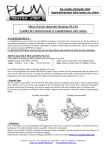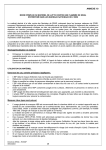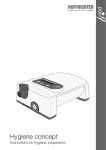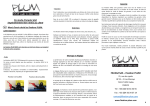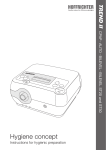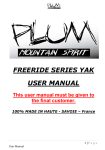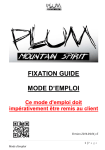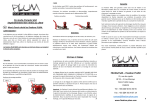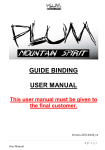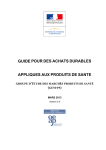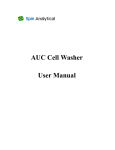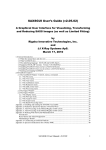Download bio-SAXS Sample Changer Maintenance manual in English
Transcript
EMBL SAMPLE CHANGER BioSAXS ID14EH3 EMBL ESRF MANUAL MAINTENANCE GUIDE Maintenance guide EMBL - ESRF Maintenance guide Bio-SAXS Sample Changer 25/05/2009 Page 2 EMBL - ESRF Bio-SAXS Sample Changer 25/05/2009 Maintenance guide Maintenance guide Page 3 EMBL - ESRF Bio-SAXS Sample Changer 25/05/2009 Summary Maintenance guide ..................................................................................................... 3 1 General informations ........................................................................................... 5 1.1 General description of the BioSAXS sample changer ................................... 5 1.1.1 SEU – Sample exposure unit .................................................................. 5 1.1.2 SCU – Sample changer unit.................................................................... 5 1.1.3 LTU – Liquid transfer unit ........................................................................ 5 1.2 Handling, qualified personnel ........................................................................ 5 1.3 ........................................................................................................................... 6 1.4 2 3 4 Safety ............................................................................................................ 6 Sample Changer start up..................................................................................... 8 2.1 Power supply ................................................................................................. 8 2.2 Pneumatic air supply ..................................................................................... 8 2.3 Engaging electricity ....................................................................................... 8 2.4 Engaging pneumatics .................................................................................... 8 Turning-off the Sample Changer ......................................................................... 9 3.1 Turning-off the electronics ............................................................................. 9 3.2 Turning-off the pneumatics ............................................................................ 9 3.3 Emergency stop............................................................................................. 9 Maintenance off the Sample Changer ................................................................. 9 4.1 Changing the particle filter ............................................................................. 9 4.2 Replacement of the SEU O-rings ................................................................ 10 4.3 Visual control of tubing and safety tray ........................................................ 10 4.4 Needle alignment control ............................................................................. 11 Maintenance guide Page 4 EMBL - ESRF Bio-SAXS Sample Changer 25/05/2009 1 General informations 1.1 General description of the BioSAXS sample changer The BioSAXS sample changer is an instrument installed on a light source (ID14-EH3 - ESRF) which allows positioning of samples in solution into an Xray beam for scientific analysis. It is composed of three modules: SEU (sample exposure unit), SCU (sample changer unit), LTU (liquid transfer unit), plus electronics and the control software. 1.1.1 SEU – Sample exposure unit The exposure cell is composed of a removable quartz capillary mounted under vacuum, which holds the liquid of interest in the X-ray beam,. This temperature controlled cell is equipped with lighting and a camera system to enable visualisation of the capillary. 1.1.2 SCU – Sample changer unit The sample changer allows sample selection by movement in two axes. It contains a cleaning station with three wells (one contains a detergent solution, one water and the third dry air). 1.1.3 LTU – Liquid transfer unit The liquid transfer unit transfers samples from the storage position in the sample well of the SCU to the measurement position in the capillary of the SEU. It allows control of the sample position in the capillary and tubing system. Further peristaltic pumps and venturi aspiration are used to deliver the cleaning solutions to the cleaning station and to clean the needle, capillary and all intermediate tubing and connectors of the system. 1.2 Handling, qualified personnel The sample changers maintenance and service must be done by qualified personal only. Any intervention such as repairs (following mechanical or electrical failure), dismounting and reinstallation of the system or any action which requires either disconnecting or reconnecting cables and tubing of the sample changer must only be undertaken by one of the following qualified persons: FELISAZ Franck FODINGER Lukas GIRAUD Thierry GOBBO Alexandre HUET Julien VILLARD Cyril Maintenance guide Tel : 7188 Tel : 7951 Tel : 2829 Tel : 7949 Tel : 7714 Tel : 7875 E-mail : [email protected] E-mail : [email protected] E-mail : [email protected] E-mail : [email protected] E-mail : [email protected] E-mail : [email protected] Page 5 EMBL - ESRF Bio-SAXS Sample Changer 25/05/2009 1.3 1.4 Safety General: the user is invited to read (on the ESRF homepage) instructions for effective safety. In particular this concerns among with others: connection of electrical apparatus, the regulations for using compromised air … Adhesive labels are placed on some elements of the sample changer. For your security it is important to follow the indicated instructions; in order to minimise risks (electrical, chemical ...) to yourself and others. It is forbidden to remove any fixed safety panels which protect the machine as well as its users. The removable Plexiglas safety cover can be removed by the user in order to load samples into the device. It is equipped with a contact sensor which cuts the power supply of the SCU motors when it is not in place to protect the user. During normal use the sample changer can be switched on and off as described in chapter §2. However, in the case of a problem the device is equipped with emergency stop buttons: • The Two emergency stop buttons of the sample changer are easily accessible: One placed on the marble table (integrated into the control panel) and one behind the SCU (mounted on the gray box housing the valves). When activated they cut the electrical power and pneumatic air supply of the sample changer. In front of the SCU Behind the SCU All ESRF beam lines have emergency stop buttons which can also be used The beam line emergency stop buttons are placed in the hutch. Those buttons cut the electrical power, - and pneumatic air supply for the whole beam line! ATTENTION !!!! : Activation of these emergency stop buttons cuts the power and will engage the PSS (safety system) of the whole beam line, including the other three experimental stations of ID14!!! Restarting all beamline equipment is a complicated (and time consuming), so just use it in real emergency. Maintenance guide Page 6 EMBL - ESRF Bio-SAXS Sample Changer 25/05/2009 Chemical and biological risks : The DETERGENT canister contains HELLMANEX II which is a corrosive product. The WASTE canister contains KORSOLEX and HELLMANEX II which are corrosive. Safety glasses and gloves must be worn (see safety data sheets) to handle these canisters. Safety data sheet HELLMANEX II: www.chem.agilent.com/Library/msds/8529EU.English.pdf Safety data sheet KORSOLEX : www.sterillium.com/sida/EN_R10232.PDF Samples, classified as RED from the ESRF are not allowed to put into the sample changer. Samples, classified as YELLOW from the ESRF are not allowed to be recuperated into the sample well after loaded into the capillary; the sample will be aspirated into the waste canister during cleaning procedure. Samples, calcified as GREEN from the ESRF can be ether recuperated into the sample well or aspirated into the waste canister during cleaning procedure. If a contamination is determined during the handling of the WASTE canister: spray KORSOLEX on a cleaning paper (both can be found in the hutch) and clean the contaminated surfaces. After use of gloves or absorbent paper they must be thrown into a yellow waste bin located in the hutch. Maintenance guide Page 7 EMBL - ESRF Bio-SAXS Sample Changer 25/05/2009 2 Sample Changer start up 2.1 Power supply The sample changer is equipped with a standard CE22 2P+T connector which is connected to the 240V-50Hz power network with a CEE 7 VII plug. 2.2 Pneumatic air supply The sample changer is fed by a pneumatic air supply >6 bars. The connector is a standard fast clip type 8mm (Festo). 2.3 Engaging electricity Engaging electricity is done using the control panel in front of the machine. - Turn the rotary switch (POWER SUPPLY) to ON: the green rotary switch should now be illuminated; the plc and the temperature controller are now on. - Push the green button (I) 24V ON: to activate the power to the motors and pumps. 2.4 Engaging pneumatics Switch on the main valve. The gauge on the pressure stat must indicate 5.5 bars (+/- 0.5 bars), if that is not correct turn the pressure stat regulator until the right pressure is indicated. Pressure stat regulator Pressure stat gauge Main valve (here in position off) Maintenance guide Page 8 EMBL - ESRF Bio-SAXS Sample Changer 25/05/2009 3 Turning-off the Sample Changer 3.1 Turning-off the electronics The electronic disabling of the sample changer is done by the control panel in front of the machine. - Press the red button (0) 24V OFF: to isolate the power to the motors and pumps. - Turn the rotary switch (POWER SUPPLY) to OFF: to cut the power to the automat and temperature controller. 3.2 Turning-off the pneumatics To turn off the pneumatics close the main valve. 3.3 Emergency stop The Sample Changer has two emergency stop buttons: one in front of the machine on the control panel, a second one behind the machine. To cut the power supply and the pneumatics just press one of this two buttons. To restart the machine one has to unlock the pressed emergency buttons by turning it clockwise. Afterwards press the green button (I) 24V ON at the control panel. 4 Maintenance off the Sample Changer 4.1 Changing the particle filter For the changing of the filter safety glasses and gloves (both stored in the hutch) must be worn. The particle filter (HEPA) should be changed: Every 2 months (i.e. during the start-up of the beamline after shutdowns) - Dismount the filter as shown on the following pictures: - Throw the used filter in one of the yellow DASRI waste bin. Maintenance guide Page 9 EMBL - ESRF Bio-SAXS Sample Changer 25/05/2009 - Put a new filter into place. 4.2 Replacement of the SEU O-rings The two O-rings shown in the design underneath must be changed every six months. Dismount the capillary (see the user’s manual), Dismount the two O-rings with small callipers or a needle, Put new O-rings into place. Note O-rings have different dimensions: O-ring n°1: Material EP851 – Dimension: 14 x 1 .78 mm O-ring n°2: Material EP851 – Dimension: 13.10 x 1.8 mm Grease the O-rings with vacuum grease for a better seal. Capillary O-ring n°1 O-ring n°2 4.3 Visual control of tubing and safety tray Control of the tubing: once a year. - Visual verification that the two tubes of the peristaltic pumps are in good condition and do not show sign of fatigue is required. If any fatigue is observed (even between maintenance periods) the tubes must be replaced (Tube: 3mm TECAN reference 20725372), - Visual verification that the tubes between venturi pumps and HEPA filter are correctly attached and in good condition is required. When required tubes must be replaced (Tube: silicone ROTH – 9747.1) - Visual verification that the tube between HEPA filter and the waste canister is correctly attached and in good condition is essential. If this is not the case those tubes must be replaced (Tube: silicone ROTH – 9747.1) Maintenance guide Page 10 EMBL - ESRF 4.4 Bio-SAXS Sample Changer 25/05/2009 Needle alignment control Needle alignment check: every two months - Remove the SCU safety cover, - Lift the cover plate to its top position (see users guide), - Put the “SC reference pin” into the third cleaning well (DRY) - Put the safety cover back in place, - Use the software application to move the motor X and motor Z to 0, - Check that the needle points to the marked centre point of the reference pin - Move the motors back into the default position - Remove the safety cover again - Remove the reference pin from the DRY well, - Detach the cover plate from the holding magnet - Replace the SCU safety cover Maintenance guide Page 11












